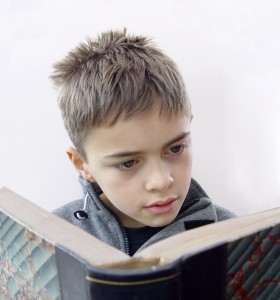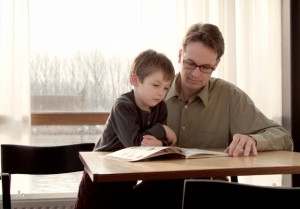 In a scientific article published in Behavioral Neuroscience, May 2013, researchers at the University of California Irvine found that environmental sensory and motor enrichment serves as an effective treatment for autism. This may be the first “official” study demonstrating that sensory/motor treatment can effect change in autistic children. (I actually applied for a government grant back in 1974 to research a significantly more comprehensive developmental-sensory/motor program. It was rejected by the government because there wasn’t any research that would show that it worked—which would have been the point of the study–but the reality is that academic institutions get the funds, not the people who are out there actually making the discoveries.) Sadly, most people in the field still don’t get it. Where would we be without such open-minded people who are in possession of such wisdom? We have since been able to compare literally thousands of children within the spectrum based on the treatments they received prior to NACD’s Targeted Developmental Intervention and with TDI, using the children as their own controls. We have been fine-tuning what works for over forty years and helping these children not only progress faster, but in some cases lose those dysfunctions and behaviors that define autism.
In a scientific article published in Behavioral Neuroscience, May 2013, researchers at the University of California Irvine found that environmental sensory and motor enrichment serves as an effective treatment for autism. This may be the first “official” study demonstrating that sensory/motor treatment can effect change in autistic children. (I actually applied for a government grant back in 1974 to research a significantly more comprehensive developmental-sensory/motor program. It was rejected by the government because there wasn’t any research that would show that it worked—which would have been the point of the study–but the reality is that academic institutions get the funds, not the people who are out there actually making the discoveries.) Sadly, most people in the field still don’t get it. Where would we be without such open-minded people who are in possession of such wisdom? We have since been able to compare literally thousands of children within the spectrum based on the treatments they received prior to NACD’s Targeted Developmental Intervention and with TDI, using the children as their own controls. We have been fine-tuning what works for over forty years and helping these children not only progress faster, but in some cases lose those dysfunctions and behaviors that define autism.
The UCI study found that providing sensory and motor input, even if not individualized to a child’s specific sensory or motor issues, leads to much better overall results than the standard treatment alone. The standard treatment included ABA (applied behavioral analysis), traditional speech therapy, occupational therapy, and social skills therapy. The researchers divided 28 autistic boys, ages 3 to 12, into two groups based on matching ages and severity of autism. The control group underwent standard therapy, and the treatment group received standard therapy along with “directed environmental enrichment.” The directed environmental enrichment included a kit of different objects that were “sensory,” but which they felt addressed common sensory-motor issues for autistic children. The kit contained essential oil fragrances for smell, squares of materials such as sandpaper and felt for touch, pieces of multi-textured materials to walk on, and items to manipulate such as a piggy bank with plastic coins for motor issues. The parents were also directed to do different exercises, such as dip their child’s hand or foot in bowls of water at varying temperatures of hot and cold, or touch the child with metal spoons that had been heated or chilled. The treatment group was directed to do two 15-30 minute sessions twice per day, with each session consisting of a few activities involving different combinations of the sensory stimulation objects and exercises. The children also listened to classical music once a day.
After six months, 69% of the parents of the treatment group children reported improvements in overall autism symptoms, compared to only 31% in the control group. Furthermore, 42% of the children in the treatment group made significant progress in social behaviors and responsiveness, compared to only 7% of the control group. The children in the treatment group also improved perception, reasoning, and other aspects of cognitive function, whereas the control group of children undergoing today’s standard treatment for autism actually had a measured decrease in cognitive function!
I actually find the results pleasantly surprising. As most of our families would testify, the amount of intervention was incredibly minimal and the intervention was neither targeted nor individualized. As we continue to learn, the more specific we can be in understanding the individual and applying very specific targeted treatment, the more effective we can be. Children with the same label can be incredibly dissimilar. I appreciate the UCI team’s work and their acknowledgement of the role of sensory/motor treatment in those within the autism spectrum and for bring this information forward. One would hope that practitioners would not now view this study and adopt the treatment regime used in this study as a model for a basis of treatment, but would open their eyes to the potential and join us in building the understanding and developing really individualized targeted programs and, based on that knowledge, to help in the development of more and better tools. Having worked with the sensory/motor issues related to autism since the late sixties, and having put information out for the public’s use for over forty years, I would hope and think that more people would be listening. This isn’t new information! It never ceases to amaze me that of the thousands of therapists and educators who view firsthand the children that work with NACD and the difference that Targeted Developmental Intervention makes, that only a handful ever want to understand what produced that change. But it only takes a few dedicated free thinkers to get involved, to help us reach a critical mass, produce a tipping point, and change perspectives and lives. I am happy to speak with or assist any researcher, therapist, physician, or educator who would like to learn more about what we have been doing for all these years and what we have found that works. After so many thousands of children from around the world and so many years of striving to understand and treat these issues better, we have actually learned a thing or two. And, as always, we are looking to help any parent who wishes to help their child.
Related Links
Original Article (PDF): Environmental Enrichment as an Effective Treatment for Autism: A Randomized Controlled Trial – Cynthia C. Woo and Michael Leon – U.C. Irvine – Behavioral Neuroscience May 2013
To learn more about NACD’s Targeted Developmental Intervention:
http://www.nacd.org/get_started/what_is_nacd.php
To learn more about NACD’s approach to treatment for autism:
http://www.nacd.org/labels/autism.php

 Today I have been seeing families in Bucharest, Romania. This is my second of eight days of seeing children and families here. I arrived in Bucharest after seeing children in Barcelona and London. Between these three cities I will have seen families from many different countries. All of these families have children with developmental issues; all of these families are dedicated to their children; and all of these families are assuming responsibility for their children and their children’s futures. They are all exceptional and can serve as models for parents and families everywhere, not just families of children with issues, but all families.
Today I have been seeing families in Bucharest, Romania. This is my second of eight days of seeing children and families here. I arrived in Bucharest after seeing children in Barcelona and London. Between these three cities I will have seen families from many different countries. All of these families have children with developmental issues; all of these families are dedicated to their children; and all of these families are assuming responsibility for their children and their children’s futures. They are all exceptional and can serve as models for parents and families everywhere, not just families of children with issues, but all families. NACD now has an extensive recommended reading list that I want to share with you. When reviewing the book list, please keep in mind that there are various ways to experience, enjoy, and learn from a book. Books should be viewed as a from of entertainment; a resource for knowledge; a means by which to develop vocabulary, build the ability to process, visualize, conceptualize, and understand information, and a means to learn about history, people, and life. Through books we can learn about fantasy, learn to imagine, dream, and create. Without the benefit of books it is very difficult to learn and understand the human condition. We can learn from the lives and experiences of others and develop a deeper understanding not only of others, but ourselves. We can gain these benefits not only by reading these books ourselves, but also through the experience of others reading them to us, from the shared experience through book clubs, from shared reading, and even from audio books. As you review this list and pick books for your child (or help them pick books), remember these options. If you want the child to enjoy a book that they are going to read themselves, you don’t want the vocabulary to be too challenging. You want them to be able to read and move through the book relatively quickly. If the book is a bit more challenging, consider shared reading. With shared reading you read a paragraph or a page, and your child reads the next. With shared reading you can help your child with any new or difficult words, and with your reading with your child you can keep the pace moving fast enough to keep it interesting. If the book is even more difficult, simply read the book to your child, or if time does not permit, see if you can find an audiobook version. Always try to encourage your child to have a dictionary handy, or preferably one of the new app dictionaries, that can give your child the pronunciation of the word as well as the definition. The best way to teach this is by example.
NACD now has an extensive recommended reading list that I want to share with you. When reviewing the book list, please keep in mind that there are various ways to experience, enjoy, and learn from a book. Books should be viewed as a from of entertainment; a resource for knowledge; a means by which to develop vocabulary, build the ability to process, visualize, conceptualize, and understand information, and a means to learn about history, people, and life. Through books we can learn about fantasy, learn to imagine, dream, and create. Without the benefit of books it is very difficult to learn and understand the human condition. We can learn from the lives and experiences of others and develop a deeper understanding not only of others, but ourselves. We can gain these benefits not only by reading these books ourselves, but also through the experience of others reading them to us, from the shared experience through book clubs, from shared reading, and even from audio books. As you review this list and pick books for your child (or help them pick books), remember these options. If you want the child to enjoy a book that they are going to read themselves, you don’t want the vocabulary to be too challenging. You want them to be able to read and move through the book relatively quickly. If the book is a bit more challenging, consider shared reading. With shared reading you read a paragraph or a page, and your child reads the next. With shared reading you can help your child with any new or difficult words, and with your reading with your child you can keep the pace moving fast enough to keep it interesting. If the book is even more difficult, simply read the book to your child, or if time does not permit, see if you can find an audiobook version. Always try to encourage your child to have a dictionary handy, or preferably one of the new app dictionaries, that can give your child the pronunciation of the word as well as the definition. The best way to teach this is by example. Got up this morning in London after experiencing some of the great joys of international travel: delayed flights, missed connections, no way to reach any of the carrier’s employees, language issues, and finally a different airline and route. But I got here.
Got up this morning in London after experiencing some of the great joys of international travel: delayed flights, missed connections, no way to reach any of the carrier’s employees, language issues, and finally a different airline and route. But I got here. I have spent this week in Barcelona, lecturing on developing cognitive function in children with Down syndrome, seeing some great families, and getting to know this new Barcelona. I traveled here and actually lived here for almost a year back in the seventies. It is incredible how much has changed in forty years. The city has grown tremendously, added a lot of new modern buildings, dramatically resurrected their port area, and really changed the complexion of the city. Since hosting the Olympics in 1992, the city has become much more diverse in its population and has become a favorite of tourists.
I have spent this week in Barcelona, lecturing on developing cognitive function in children with Down syndrome, seeing some great families, and getting to know this new Barcelona. I traveled here and actually lived here for almost a year back in the seventies. It is incredible how much has changed in forty years. The city has grown tremendously, added a lot of new modern buildings, dramatically resurrected their port area, and really changed the complexion of the city. Since hosting the Olympics in 1992, the city has become much more diverse in its population and has become a favorite of tourists.